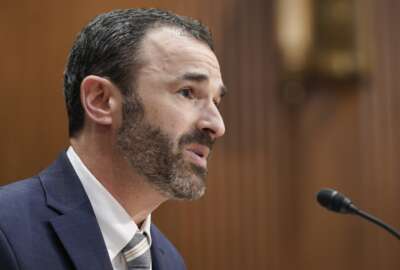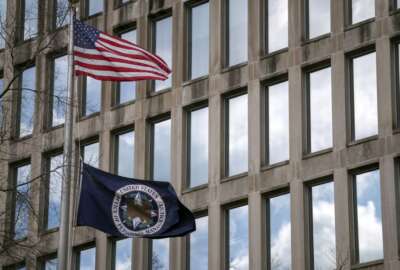If you care about U.S. trade violation activity, there’s now a dashboard for that
U.S. Customs and Border Protection (CBP) has launched two oversight platforms anyone can view to see what's going on in trade violation and enforcement actions.
Trade with other countries, is something nations both promote and protect like crown jewels. Now U.S. Customs and Border Protection (CBP) has launched two oversight platforms anyone can view to see what’s going on in trade violation and enforcement actions. For details on the two new dashboards, the Federal Drive with Tom Temin spoke with CBP’s Executive Assistant Commissioner for Trade, AnnMarie Highsmith.
Interview Transcript:
Tom Temin So tell us about these dashboards. What is it they show and what do you hope to get accomplished with them?
AnnMarie Highsmith So we have two new dashboards that are included as part of our online trade violations reporting tool. The first tool is the e-Allegation statistics dashboard. And that dashboard shows multiple types of reported trade violations, including when companies don’t follow labor laws or safety rules. The second tool is called the Enforce and Protect Act, or EAPA Statistics Dashboard, and that one focuses on a specific problem and that is anti-dumping countervailing duty violations. And that means companies that are trying to sell their products in the United States without paying the right duties, taxes and fees.
Tom Temin And were these dashboards mandated by a statute, or is it something that CBP felt it just wanted to get out there information wise?
AnnMarie Highsmith So these are CBP’s efforts to be more transparent and to improve understanding and information sharing in these important trade areas.
Tom Temin Well, let’s talk about the e-Allegations statistics. These say are violators of labor laws and safety rules. These are allegations against U.S. companies or companies that are bringing goods into the United States otherwise legitimately?
AnnMarie Highsmith Well, these are all types of violations in our trade space. These tools, the trade violations reporting tool and the e-allegations portal are publicly available to anyone who has an internet connection. And you can submit online all types of violations. We deal a lot with forced labor laws, health and safety, counterfeiting, false countries of origin, all the laws that the U.S. Customs and Border Protection enforces at the border, including unfair trade practices such as anti-dumping and countervailing duties.
Tom Temin Well, are these the allegations that are brought by CBP, or could they also be brought by other, say, Commerce Department, for example, entities?
AnnMarie Highsmith The dashboard in particular reports and collates allegations that are made by the public through the portal. It’s not inclusive of all investigative and enforcement casework that is undertaken by the agency, but rather those that are made by outside entities. We do get them from trade associations, also individuals and corporations. One thing to note is that a primary driver of the development of the e-allegations dashboard was that once the allegations were made by CBP, the folks that made those allegations didn’t have an easy way to track what we were doing with them. And so this will help shine a light on the types of allegations we’re getting and what we’re doing with them.
Tom Temin Yes so if someone alleges, say, a trade association or maybe a manufacturer says, hey, look, these watches coming in are not really our watches or our clothing, there’s so many cases. What happens at that point, they make the allegation to CBP, and then CBP does what then?
AnnMarie Highsmith So we pick it up and depending on the information that’s given, we triage it and then take the next appropriate steps. Sometimes that’s sending out requests for further information to the alleger or to the alleged violator. Two related parties. Sometimes it includes, well usually includes running through our own systems, checking against the data that we have on those importations. And sometimes it involves shifting the allegations to other parties who are more focused on handling the type of violation that’s alleged.
Tom Temin We are speaking with AnneMarie Highsmith, executive assistant commissioner for trade at U.S. Customs and Border Protection, and on the enforcement and protected EAPA counterfeiting site. The other dashboard, this then depicts things that CPB has done that you’re starting to do from the allegations. Fair to say?
AnnMarie Highsmith So the EAPA dashboard does, in fact focus on that one specific problem, dumping, which is attempts by foreign manufacturers to sell their merchandise in the United States at unfairly low prices. Which caused harm to US businesses, because they just can’t compete against that unfair trade practice. And so we do investigate to see if these companies are breaking the rules. And if they are, we take steps to enforce those rules and level the playing field for our U.S. businesses. That could mean charging additional duties, collecting revenue and duties that were not paid correctly, and as well as penalties and potentially criminal violations. So the dashboard is a public tool that’s designed to enhance transparency and provide detailed information into our enforcement activity in this trade space.
Tom Temin Well, who tends to bring anti-dumping types of allegations? Because you need to have some data about the costs incurred by that foreign manufacturer to know if they’re dumping or not. You might be able to infer that from low prices, but you don’t really know what their cost inputs are.
AnnMarie Highsmith Usually, it’s the U.S. competitors who bring those allegations and say this foreign manufacturer is selling to my domestic customers. There’s no way they can be producing this merchandise at this low price, because I know how much it costs for me to produce it. Sometimes they have more specific information that they derive from sources and inputs that may be in the same country. Labor inputs through their trade associations, they get detailed information. So we have the ability to examine that data, and then also compare it to information that we have in our own holdings in order to reach conclusions.
Tom Temin It sounds like the federal government, which ultimately enforces trade regulations and laws, though, has kind of an army of supporters in the people in the private sector that are actually affected by illegal trade activity and dumping.
AnnMarie Highsmith It is one of the privileges that we have here at U.S. Customs and Border Protection, and that is to protect U.S. industry from unfair trade practices and to ensure that there’s a level playing field so that industry, American businesses, communities and families can grow and thrive in our business environment. And that is a measure of economic security that we provide to the American public. I will note, too, that these dashboards are an important tool for those U.S. businesses who are seeking to secure their supply chains, and that it gives them data on trends and hotspots and risky locations so they can make good business decisions to eliminate violations or potential violations that will disrupt their supply chain.
Tom Temin And how many cases are going on at a given time in a year? Or is it tens? Thousands? Millions?
AnnMarie Highsmith We do get several hundred allegations. We get them on a regular basis, and we take action on all of them within a spectrum. Some allegations don’t have sufficient information or have other challenges, but we do take action as quickly as we are able. And the public can see that those results on our dashboard.
Copyright © 2025 Federal News Network. All rights reserved. This website is not intended for users located within the European Economic Area.
Tom Temin is host of the Federal Drive and has been providing insight on federal technology and management issues for more than 30 years.
Follow @tteminWFED






